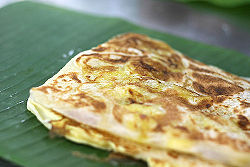Roti canai

Roti canai
|
|
| Alternative names | Roti cane |
|---|---|
| Type | Flatbread |
| Place of origin | Malaysia |
| Region or state | Malaysia, Brunei, Indonesia,Singapore, Thailand |
| Created by | Malaysian Indian cuisine |
| Serving temperature | Hot |
| Main ingredients | Flour |
| Variations | Paratha |
| |
|
Roti canai (pronunciation tʃanai) or roti cane (pronunciation tʃane) is a type of Indian-influenced flatbread found in Malaysia, Brunei, Indonesia and Singapore. It is often sold in Mamak stalls in Malaysia; also in Malay, Minangkabau and Aceh restaurants in Indonesia. It is known as roti prata in Southern Malaysia and Singapore, and is similar to the Indian Kerala porotta. It is also found throughout Thailand, where it is called "Ro Tee" and is typically sold by Muslims, most often from street carts, and is usually Halal.
In English and in Chinese, roti canai is sometimes referred to as "flying bread" (飞饼 fēibǐng), a term that evokes the process of tossing and spinning by which it is made. In Chinese, Roti canai is originally called 印度煎饼 "yìn dù jiān bǐng", which means Indian pancake.
Traditionally roti canai is served with dhal (lentil curry) or any type of curry, such as mutton or chicken curry. However, the versatility of roti canai as the staple lends itself to many variations, either savoury or sweet, with a variety of toppings and fillings, which includes eggs, banana, sardines and onion. In Thailand, it is usually served sweet - typical fillings include condensed milk, peanut butter, jam and nutella, without the curry.
Roti means bread in Hindi, Urdu, most other North Indian languages, and Malay. The term "canai" may be derived from:
The dish is composed of dough containing copious amounts of fat, flour and water. The form of fat used is usually ghee (clarified butter). Some people add sweetened condensed milk to the mix. The entire mixture is kneaded thoroughly, flattened, oiled and folded repeatedly. It is then allowed to proof and rise, and the process is repeated. These days, many restaurants do not prepare the dough themselves, tubs of prepared balls of dough are delivered by truck from a central facility. The final round of preparation consists of flattening the dough ball, spreading it out until paper thin (this is usually done by "tossing" it on a flat surface), and then gathering this thin sheet of dough into a long rope-like mass. This "rope" is then wound into a knot or spiral and then flattened, so the ideal roti consists of thin flakes of dough when cooked, fluffy on the inside and crisp on the outside. Up until the 1970s it was common for cooks to make the "rope" quite long and form a spiral that went around several times (much like the modern "roti bom"), but this is no longer the case, probably because the amount of dough used per roti is about half of what it used to be, and a roti made this way would be only the size of a "roti bom". When making varieties with fillings, however, the fillings (be it egg, chopped onions, etc.) is spread or sprinkled on the thin sheet of dough, which is then folded into a square, trapping the fillings inside.
...
Wikipedia
